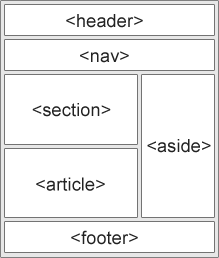New Semantic Elements in HTML5
They are <div></div> by themselves
Many of existing web sites today contains HTML code like this: <div id="nav">, <div class="header">, or <div id="footer">, to indicate navigation links, header, and footer.
HTML5 offers new semantic elements to clearly define different parts of a web page:
- <header>
- <nav>
- <section>
- <article>
- <aside>
- <figcaption>
- <figure>
- <footer>

The <section> element defines a section in a document.
The <article> element specifies independent, self-contained content.
The <nav> element defines a set of navigation links.
The <aside> element defines some content aside from the content it is placed in (like a sidebar).
The <header> element specifies a header for a <article> or <section>.
The <footer> element specifies a footer for a <article> or <section>.
HTML5 <figure> and <figcaption> Elements
<figure>
<img height="100" src="http://24.media.tumblr.com/tumblr_me8rxmQrvO1rnvhfco1_1280.jpg" width="150" />

<figcaption>Fig1. - This is the logo of Google.</figcaption>
</figure>
Can We Start Using These Semantic Elements?
The elements explained above are all block elements (except <figcaption>).
To get these elements to work properly in all (older) major browsers, set the display property to block in your style sheet (this causes older browsers to render these elements correctly):
header, section, footer, aside, nav, article, figure
{
display: block;
}
| block | The element is displayed as a block-level element (like paragraphs and headers) |
No comments:
Post a Comment